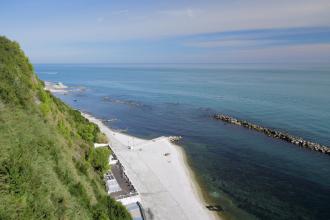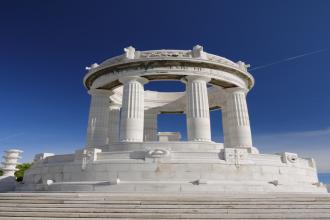Ancona is a city where you can discover day after day traditions, views that will leave you speechless and its historic sites that recount us about the deep roots of this city.
Ancona was founded in 387 B.C. by the Dorians and for many centuries has been a crossroads of peoples and cultures. Their passage remains today as an indelible mark on the many artistic works that form the backdrop to the bustling streets of the historic centre.
Today Ancona is the perfect destination for those of you who are looking for relax, good food and good wine.
You will visit a city with cliffs overlooking the sea, long beaches and wild coves.
Ancona is also green. In fact, in addition to the many parks that populate the heart of the city, Ancona gives you the opportunity to discover the Parco del Conero: a gorgeous mountain which overlooks the sea.
Immediately behind the beaches and the blue sea of the Riviera del Conero (Ancona is part of it), you will discover the surroundings. Here, between rolling hills coloured by vineyards and fields of wheat and lavender, there are really ancient and fascinating cities as Urbino, Loreto or the Grotte of Frasassi .
We suggest you go to the Art Gallery of Ancona housed in Palazzo Bosdari where you can admire some local paintings of extraordinary value painted between the fourteenth and nineteenth centuries .
Another thing that you should visit is the National Archaeological Museum of Marche is located in the sixteenth century Palazzo Ferretti. Here, Neolithic arrowheads, antique jewellery, Roman vases and many precious relics will tell you the history of our civilisation.
Among the most interesting monuments of the city there is the Cathedral of San Ciriaco: built on the ruins of a Greek temple and an early Christian church, today this Cathedral dominates Ancona from the top of Colle Guasco. The exterior facade of the Cathedral was designed by Vanvitelli as well as the Mole Vanvitelliana (or Lazaretto).
The Mole Vanvitelliana is a pentagonal construction built on the sea: the Lazzaretto, which in past days was a hospital, today is one of the cultural centres of the city.
From the Mole Vanvitelliana, turning towards the city, with the sea behind you, you’ll notice another symbol of Ancona: the Arch of Traiano. This monument , built between 110-116 AD , as well as the Roman amphitheater (built in the first century BC during the empire of Caesar Augustus) are evidence of the splendour of Ancona during the Roman.
Walking, then, to the downtown of Ancona and stop in Piazza del Plebiscito (or Piazza del Papa) where you can visit the Church of San Domenico, which houses The Crucifixion of Tiziano, a paint of inestimable value.
Walking down the narrow streets that lead from Piazza del Papa at the port and you will see the Teatro delle Muse where, every year, are staged major operas and theatres .
In your tour exploring Ancona let’s visit a peculiar place. Just below the War Memorial Monument (Passetto) down the stairs leading to the sea you’ll find one of the typical symbol of the city. Overlooking the sea there are, one behind the other, the Caves of the Passetto. You will recognise them because of their hand-painted and colourful doors .
You will meet, then , the Chair of the Pope: an oddly shaped rock where every child of Ancona, at least once in his life, thrown himself into the blue sea.
Useful information to visit the Art Gallery of Ancona: www.musan.it
Useful information to visit the National Archaeological Museum of Marche: www.archeomarche.beniculturali.it
Useful information to visit the Teatro delle Muse: www.teatrodellemuse.org







